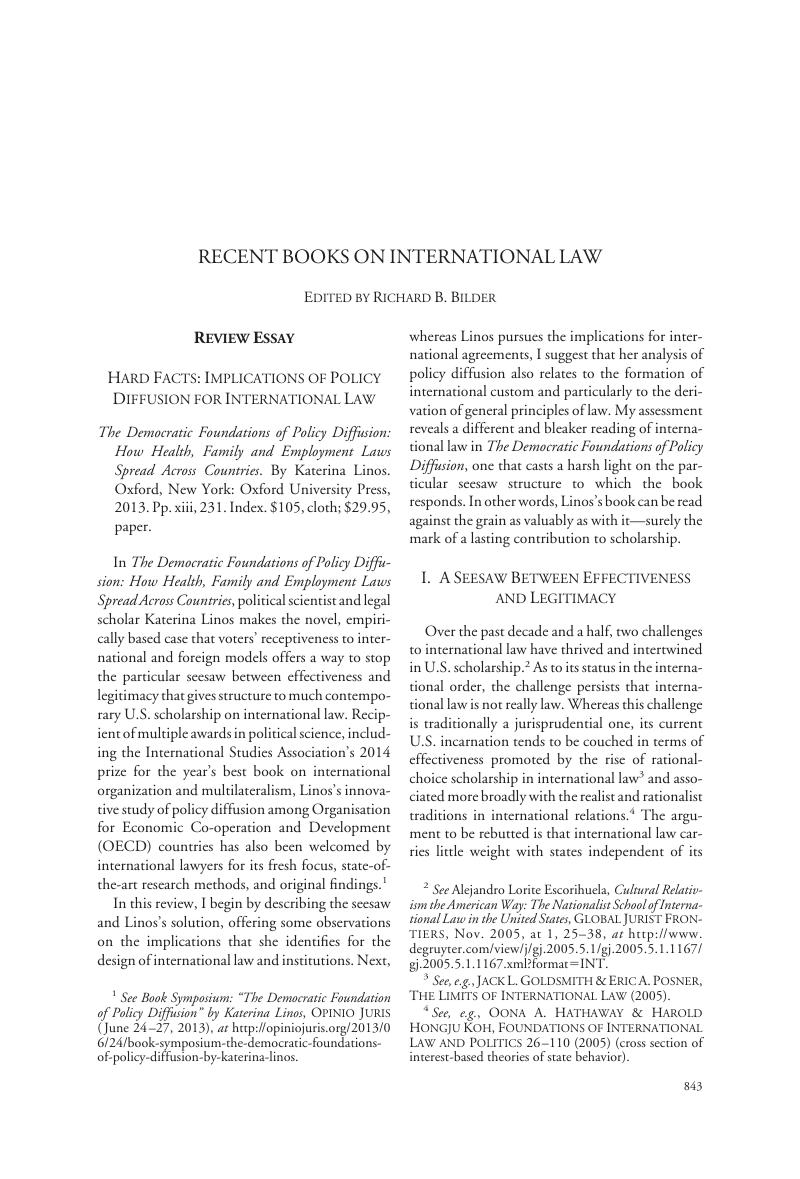No CrossRef data available.
Article contents
Hard Facts: Implications of Policy Diffusion for International Law - The Democratic Foundations of Policy Diffusion: How Health, Family and Employment Laws Spread Across Countries. By Katerina Linos. Oxford, New York: Oxford University Press, 2013. Pp. xiii, 231. Index. $105, cloth; $29.95, paper.
Published online by Cambridge University Press: 20 January 2017
Abstract

- Type
- Recent Books on International Law
- Information
- Copyright
- Copyright © American Society of International Law 2014
References
1 See Book Symposium: “The Democratic Foundation of Policy Diffusion” by Katerina Linos, Opinio Juris (June 24–27, 2013), at http://opiniojuris.org/2013/0 6/24/book-symposium-the-democratic-foundations-of-policy-diffusion-by-katerina-linos.
2 See Alejandro Lorite Escorihuela, Cultural Relativism the American Way: the Nationalist School of International Law in the United States, Global Jurist Frontiers, Nov. 2005, at 1, 25–38, at http://www.degruyter.com/view/j/gj.2005.5.1/gj.2005.5.1.1167/gj.2005.5.1.1167.xml?format=INT.
3 See, e.g., Jack L. Goldsmith & Eric A. Posner, the Limits of International Law (2005).
4 See, e.g., Oona A. Hathaway & Harold Hongjukoh, Foundations of International Law and Politics 26–110 (2005) (cross section of interest-based theories of state behavior).
5 See, e.g., Alford, Roger P., Misusing International Sources to Interpret the Constitution, 98 AJIL 57, 58–61 (2004)CrossRefGoogle Scholar. But See Powell, Catherine, Lifting Our Veil of Ignorance: Culture, Constitutionalism, and Women’s Human Rights in Post-September 11 America, 57 Hast Ings L.J. 331, 354 (2005)Google Scholar (arguing in the context of women’s international human rights that U.S. objections framed in constitutional terms as democratic are better understood as cultural).
6 Escorihuela, supra note 2, at 25–38.
7 Shaffer, Gregory & Ginsburg, Tom, The Empirical Turn in International Legal Scholarship, 106 AJIL 1 (2012)CrossRefGoogle Scholar.
8 Beth A. Simmons, Mobilizing for Human Rights:International Law in Domestic Politics 114 (2009).
9 Id. at 125–55.
10 See, e.g., Anne-Marie Slaughter, A New World Order (2004).
11 See, e.g., Kingsbury, Benedict, Sovereignty and Inequality, 9 Eur. J. Int’l L. 599, 622–25 (1998)CrossRefGoogle Scholar; Martti Koskenniemi, Global Governance and Public International Law 16 (Feb. 9, 2004), available at http://www.helsinki.fi/eci/Publications/Koskenniemi/MFrankfurt.pdf.
12 Koh, Harold Hongju, The 1998 Frankel Lecture: Bringing International Law Home, 35 Hous. L. Rev. 623 (1998)Google Scholar.
13 Posner, Eric Cf., Linos Book Symposium: Comments by Eric Posner, Opinio Juris (June 25, 2013), at http://opiniojuris.org/2013/06/25/linos-book-symposium-comments-by-eric-posner (hypothesizing that Linos’s book “suggests that international law is weaker than is generally recognized”)Google Scholar.
14 Declaration of Alma-Ata, Art. VIII, International Conference on Primary Health Care, Alma-Ata, USSR (Sept. 1978), available at http://www.who.int/publica tions/almaata_declaration_en.pdf.
15 Evidence in the form of a UN recommendation might also be more accessible, although that advantage would not be relevant to Linos’s survey results.
16 I relate Linos’s findings to customary international law in part III infra.
17 Fora constitutional case that might be described as turning on policy diffusion of different kinds, see United States v. Burns, [2001] 1 S.C.R. 283 (Can.).
18 Linos touches on the possibilities that a UN endorsement might send a message about basic standards and universal rights (p. 43) and that an international organization might have a reputation for technical expertise in the relevant area (p. 32).
19 Statute of the International Court of Justice, Art. 38(1)(c), June 26, 1945, 59 Stat. 1055, TS No. 993.
20 See, e.g., Michael Byers, Custom, Power and the Power of Rules: International Relations and Customary International Law 35–50 (1999); Vagts, Detlev F., Hegemonic International Law, 95 AJIL 843, 847 (2001)CrossRefGoogle Scholar.
21 See, e.g., Anghie, Antony, Finding the Peripheries: Sovereignty and Colonialism in Nineteenth-Century International Law, 40 Harv. Int’l L.J. 1, 65– 69 (1999)Google Scholar; Kingsbury, supra note 11, at 616 –22; Schneiderman, David, The Global Regime of Investor Rights: Return to the Standards of Civilised Justice?, 5 Transnat’l Legal Theory 60 (2014)CrossRefGoogle Scholar.
22 Kingsbury, supra note 11, at 621 (footnote omit ted).
23 See generally, e.g., Antony Anghie, Imperialism, Sovereignty and the Making of International Law 32–114 (2005).
24 Statute of the International Court of Justice, supra note 19, Art. 38(1)(c).
25 See, e.g., International Status of South-West Africa, Advisory Opinion, 1950 ICJ Rep. 128, 147–53 (July 11) (sep. op. McNair, J.) (referring generally to “[n]early every legal system” but discussing only the Anglo-Commonwealth and French legal systems); Ellis, Jaye, General Principles and Comparative Law, 22 Eur. J. Int’l L. 949, 957 (2011)CrossRefGoogle Scholar.
26 See, e.g., Gerry Simpson, Great Powers and Outlaw States: Unequal Sovereigns in the International Legal Order 238–42 (2004); Martti Koskenniemi, Race, Hierarchy and International Law: Lorimer’s Legal Science (forthcoming) (on file with author).
27 1 James Lorimer, the Institutes of the Law of Nations 101–03 (1883). International legal historians are increasingly separating the semi-periphery from the periphery as a critical focus. See, e.g., Lorca, Arnulf Becker, Universal International Law: Nineteenth-Century Histories of Imposition and Appropriation, 51 Harv. Int’l L. J. 475 (2010)Google Scholar; The League of Nations and the Construction of the Periphery, 24 Leiden J. Int’l L. 797–922 (2011) (special issue).
28 See Simpson, supra note 26, at 238.
29 Lorimer, supra note 27, at 182– 88; see also Koskenniemi, supra note 26, at 4–7, 9–11.
30 Lorimer, supra note 27, at 103.
31 Id. at 181.




